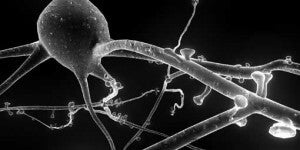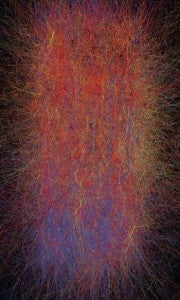Creating a virtual model of the human brain is one thing. I do it all the time, doodling little cerebrums while I talk on the phone. But getting your model to behave just like its flesh-and-blood counterpart? That’s a Frankenstein moment right there. Researchers with the Swiss-based Blue Brain Project have just created a virtual pack of neurons that acts just like the real thing, and hope to get an e-brain up and running. I hope somebody yelled “It’s alive!”

Launched by the EPFL in 2005, the Blue Brain Project is an attempt to reverse-engineer the brain. As most folks know, the human brain is made up of lots (and lots and lots) of neurons – around 100 billion or so. These neurons connect and communicate with each other through a dizzying network of something like 100 trillion synapses. If these numbers are making your own brain hurt, you now have a sense for how hard it is to make an artificial brain.
But all hope is not lost. Genes don’t really code the body like blueprints do for a building, mapping out every single detail; instead, they give a more general instruction and hit the “repeat” button a few million times (e.g. when they give fractal instructions). This means that amid the great complexity of the whole brain, there are structural units that repeat themselves. One such structure is called a neocortical column (NCC): a group of about 10,000 neurons in the cerebral cortex that are organized in a relatively consistent way across the mammalian brain. Millions of these columns compose the whole of your grey matter.
Rather than trying to create a model of the whole brain at once, the Blue Brain Project is attempting to accurately model a single NCC in a rat’s brain. If they can create an artificial column that responds the same way that biological ones do to electrical impulses, they’ll be on the right track to building a good model. And this is exactly what they’ve done: built a virtual copy of an NCC down to the molecule, and had it replicate in simulation the real-world activity of rat brain tissue. And because the NCC’s structure is so consistent across mammals, they could eventually use the same simulation (scaled up, of course) to model the human brain.
Check out this video that flies you through their virtual brain:
The Blue Brain runs on IBM’s Blue Gene/L supercomputer, one of the top five supercomputers on the planet. Containing over 8,000 processors, the Blue Gene provides the tremendous amount of parallel computation (about 22 trillion operations per second) needed to simulate the complex functioning of a virtual NCC. Still, even with their current hardware, the simulation only runs at about half the speed of a biological NCC. Speeding the model up to real-time will take even stronger computers. Also, the current computing power is stretched thin to simulate a single cortical column; imagine the power needed to replicate a whole brain (millions of NCCs). The ultimate goals of the project (e.g. a virtual human brain) will require advances in computer power that just aren’t around yet.
Phase I of the research project is now complete (creating a virtual model that replicates real-life NCC behavior). The next step is to further fine-tune their model, integrating more molecular and genetic information into their simulations. To add these details, the project is upgrading their hardware to a stronger Blue Gene supercomputer that can handle the additional computations. Further stages of the project will aim to build a whole brain (not just a column): first the rat, then onward and upward to other species.
I’d encourage you to take a quick moment at this point to marvel at the awesome power of the three pounds of meat housed in your skull. The fastest, most efficient computers on the planet are barely sufficient to model even a tiny fraction of your neural tissue. Our own engineering algorithms pale in comparison to what mother nature has cooked up, though (to our credit) she had a little more time to work on her science project. Needless to say, this speaks to how much we have to learn from the efficiency of biological adaptations.

Like most labs in this flowering economy, the Blue Brain Project needs further funding to take the next step. “It’s not a question of years, it’s one of dollars,” Henry Markram, leader of the Project, told BBC. “The psychology is there today and the technology is there today. It’s a matter of if society wants this. If they want it in 10 years, they’ll have it in 10 years. If they want it in 1000 years, we can wait.” Funding thus far has come from the Swiss government and private grants; IBM sold their supercomputers at a discount to see what kinds of new applications EPFL would come up with.
Despite the similarities to neural nets chasing after AI, the Blue Brain Project isn’t trying to build HAL9000. Their goal is to explore how the brain functions and to provide a useful tool to the field of neuroscience, both for research and clinical purposes. But while their primary goal may be physiological simulation for doctors, they admit they might unlock a few secrets to consciousness along the way. Well as long as it’s convenient…
If the Project can secure more funding – and this recent breakthrough might help – they’ll be able to afford more of the supercomputing power needed to add details and scale up their model. A virtual brain that mimics the behaviors of a real brain would be an invaluable tool for researchers and doctors alike. And who knows? Maybe “It’s alive!” will take on a whole new meaning.


